Before you Begin
This tutorial shows you how to use Oracle Autonomous Data Warehouse AutoML in an Oracle Analytics data flow to build a prediction model without a data science background.
Background
As a business analyst, citizen data scientist, or expert data scientist, you can build and deploy machine learning models in Oracle Analytics using datasets created from Oracle Autonomous Data Warehouse. You don't need a deep understanding of specific algorithms and the modeling process to build and refine usable models.
The AutoML data flow step chooses the appropriate algorithm from the supported algorithms and identifies the features and tuning to use with your data. The selected target value determines whether the Task Type is a classification or regression type. In this example, AutoML chooses Classification for the Task Type because ATTRITION is a Text data type. The Model Ranking Metric indicates to the AutoML process which metric to use in assessing the model quality.
After generating the model from the data flow, you can use it to score your dataset using the Apply Model step in an Oracle Analytics data flow.
What Do You Need?
- Access to Oracle Analytics
- Access to an Oracle Autonomous Data Warehouse dataset with a user that has OML Developer and DWROLE database roles
The Oracle Autonomous Data Warehouse user creating a dataflow using AutoML can't have administrative privileges.
Create a Dataflow
In this section, you create a dataflow using an Oracle Autonomous Data Warehouse dataset, and add the dataflow steps to complete and run the dataflow generating a prediction model.
- Sign in to Oracle Analytics.
- On the Home page, click Create, and then click Dataflow.
- In Add Data, select an Oracle Autonomous Data Warehouse dataset, and click Add.
This example uses an employee attrition dataset for the AutoML example.
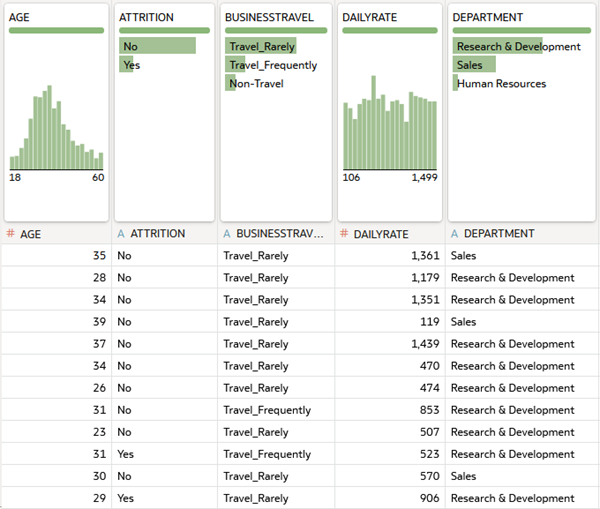
Description of the illustration emp_att_dataset.png - In Data Flow Steps, double-click AutoML. In AutoML, click Select a column next to Target, and then select the column to use from the Available Data list.
In this example, ATTRITION is the target column. AutoML chooses the best algorithm for the Task Type and Model Ranking Metric for your data. The Task Type is Classification and the Model Ranking Metric is Accuracy.
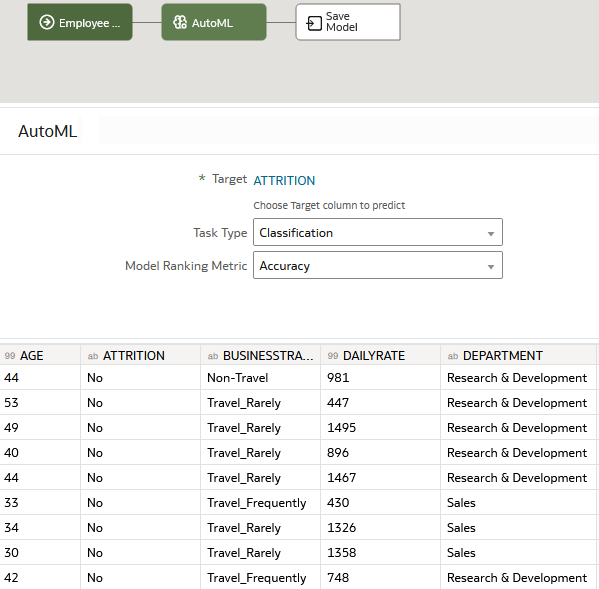
Description of the illustration automl.png - In the dataflow, click the Save Model node. In Save Model, enter a name in Model name.
In this example, the model name is employee_attrition_model.
- Click Save
 . In Save Data Flow As, enter a name, and then click OK.
. In Save Data Flow As, enter a name, and then click OK.In this example, the dataflow name is emp_attr_df.
- Click Run
 to generate the prediction model.
to generate the prediction model. - Click Go back
 .
.
Review the Prediction Model
In this section, you review Inspect to find details about the generated model and the model's quality.
- On the Home page, click Machine Learning.
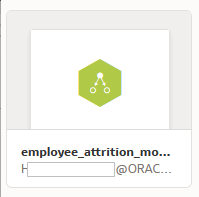
Description of the illustration ml_model.png - Hover over your model generated by AutoML, click Actions
 , and then select Inspect.
, and then select Inspect.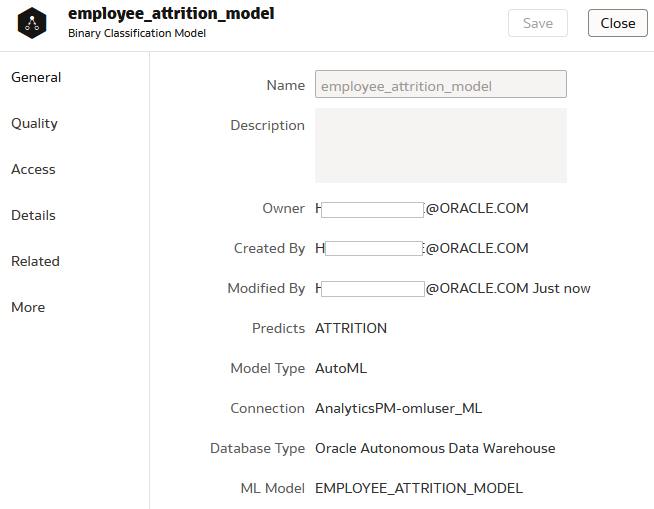
Description of the illustration model_info.png - Click Quality to view the model accuracy and precision information.
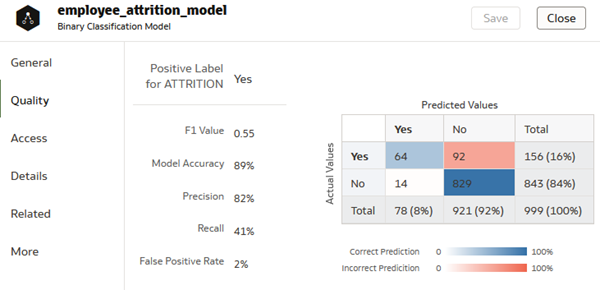
Description of the illustration model_quality.png - Click Details to view the input columns, output columns, and parameters used in generating the model.
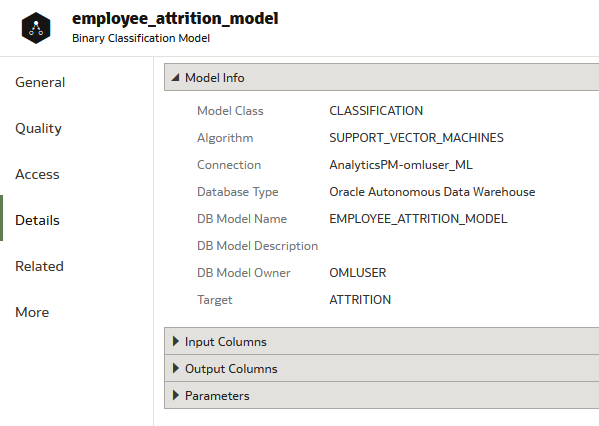
Description of the illustration model_parameters.png - Click Related to view the generated datasets.
You can create visualizations with the generated datasets.
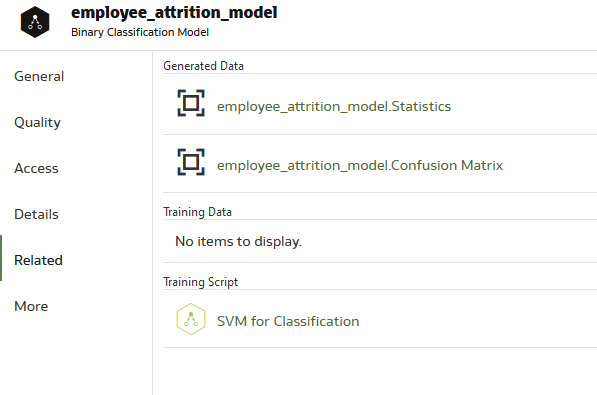
Description of the illustration model_gen_data.png - Click More to see the generated metadata.
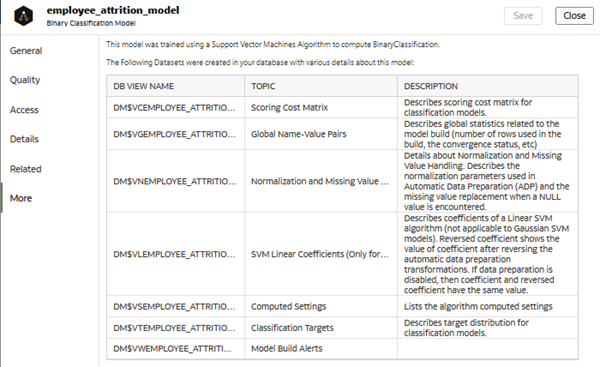
Description of the illustration model_more.png - Click Close.
Learn More
Create a Prediction Model with AutoML in Oracle Analytics
F77491-02
March 2024
Copyright © 2024, Oracle and/or its affiliates.
Learn how to create a prediction model with an Oracle Autonomous Data Warehouse dataset in Oracle Analytics.
This software and related documentation are provided under a license agreement containing restrictions on use and disclosure and are protected by intellectual property laws. Except as expressly permitted in your license agreement or allowed by law, you may not use, copy, reproduce, translate, broadcast, modify, license, transmit, distribute, exhibit, perform, publish, or display any part, in any form, or by any means. Reverse engineering, disassembly, or decompilation of this software, unless required by law for interoperability, is prohibited.
If this is software or related documentation that is delivered to the U.S. Government or anyone licensing it on behalf of the U.S. Government, then the following notice is applicable:
U.S. GOVERNMENT END USERS: Oracle programs (including any operating system, integrated software, any programs embedded, installed or activated on delivered hardware, and modifications of such programs) and Oracle computer documentation or other Oracle data delivered to or accessed by U.S. Government end users are "commercial computer software" or "commercial computer software documentation" pursuant to the applicable Federal Acquisition Regulation and agency-specific supplemental regulations. As such, the use, reproduction, duplication, release, display, disclosure, modification, preparation of derivative works, and/or adaptation of i) Oracle programs (including any operating system, integrated software, any programs embedded, installed or activated on delivered hardware, and modifications of such programs), ii) Oracle computer documentation and/or iii) other Oracle data, is subject to the rights and limitations specified in the license contained in the applicable contract. The terms governing the U.S. Government's use of Oracle cloud services are defined by the applicable contract for such services. No other rights are granted to the U.S. Government.
This software or hardware is developed for general use in a variety of information management applications. It is not developed or intended for use in any inherently dangerous applications, including applications that may create a risk of personal injury. If you use this software or hardware in dangerous applications, then you shall be responsible to take all appropriate fail-safe, backup, redundancy, and other measures to ensure its safe use. Oracle Corporation and its affiliates disclaim any liability for any damages caused by use of this software or hardware in dangerous applications.
Oracle and Java are registered trademarks of Oracle and/or its affiliates. Other names may be trademarks of their respective owners.
Intel and Intel Inside are trademarks or registered trademarks of Intel Corporation. All SPARC trademarks are used under license and are trademarks or registered trademarks of SPARC International, Inc. AMD, Epyc, and the AMD logo are trademarks or registered trademarks of Advanced Micro Devices. UNIX is a registered trademark of The Open Group.
This software or hardware and documentation may provide access to or information about content, products, and services from third parties. Oracle Corporation and its affiliates are not responsible for and expressly disclaim all warranties of any kind with respect to third-party content, products, and services unless otherwise set forth in an applicable agreement between you and Oracle. Oracle Corporation and its affiliates will not be responsible for any loss, costs, or damages incurred due to your access to or use of third-party content, products, or services, except as set forth in an applicable agreement between you and Oracle.